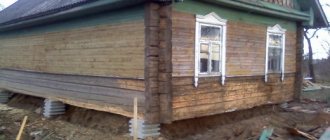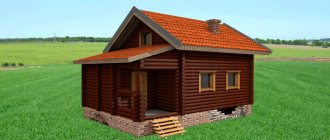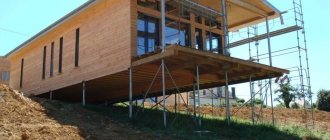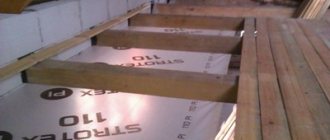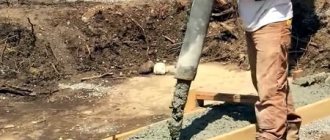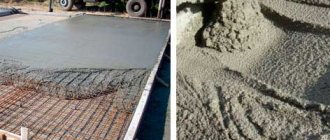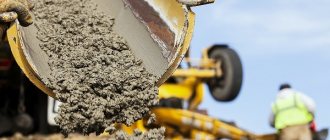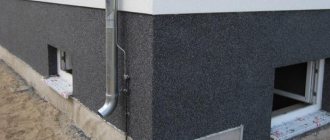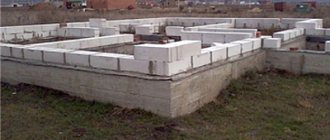The foundation is the main component of buildings. Over time, any structure can partially collapse or fail completely. Restoring or replacing the foundation of a wooden house will help extend the life of the structure. In this review we will look at working repair methods.
Destruction under a wooden house Source sdelai-lestnicu.ru
How to determine a breakdown
The longevity of a building often depends on its foundation. It’s easy to guess about problems with the structure by skewed partitions and difficulties when opening window or door sashes. The cottage may collapse on one side.
Before replacing the foundation under a wooden house, you need to determine the culprit of the breakdown. Professionals identify 5 main problems:
- Lowering the cottage into the soil. Old buildings “sink” into the ground after a few decades.
- Wear of the structure. Defects in the foundation manifest themselves in the form of rotten logs, crumbling masonry and bricks.
- Skewed piles. If there are errors in the calculations at the construction stage, a noticeable curvature of the structure occurs.
- Cracks, chips. Problems arise when the monolithic foundation in a wooden house is damaged. They appear both as single elements and as a whole network of slots.
- Column destruction. The cottage becomes deformed if the integrity of at least one of the supporting parts is damaged.
The base can change its correct geometry under the influence of external factors. The foundation of a wooden house is broken by overgrown tree roots or groundwater. The culprits of the problem are hidden from view, so they are not always noticeable in the early stages.
Causes of destruction
Any house built on a foundation can last for quite a long time, but in some cases its service life can be significantly reduced if cracks are found in the foundation. The beginning of destruction can lead to cracks in the walls, which, in turn, can cause the complete collapse of the structure.
When identifying any cracks, you need to track the dynamics of their increase. If there is one, then it is urgent to intervene and repair the problem area. If the cracking was a one-time occurrence and is no longer moving, then it is enough to eliminate it, and there will be no problems in the future. The easiest way to find out about the nature of the damage is with the help of plaster beacons: they are placed in the desired place across the crack, then wait several days. After two or more days, you can evaluate the result - if the lighthouse is intact, then everything is in order, cosmetic repairs are needed.
If the damage is serious and there are breaks in the beacon, then it is important to urgently begin to restore the normal appearance of the foundation for the house
In order to prevent such situations from reoccurring, it is still necessary to determine why exactly the destruction of the foundation began and what reason influenced it. Several factors may be most likely.
- Increasing the mass of the building, which was originally much smaller. All kinds of extensions, the organization of a second floor or attic can add weight that the foundation is not ready to support.
- Ground movement due to natural phenomena. Summer heat, autumn-spring rains and winter cold cause an increase and decrease in the size of the soil, which affects the foundation from year to year, and sooner or later can seriously deform it.
- Problems associated with violation of the waterproofing system, which should be laid during the formation of the foundation.
- Emergency situations due to the use of communications. This could be a rupture of a water or sewer line, which will allow a large amount of liquid to impact the foundation of the house, destroying it.
- Groundwater, which may be too much. Without studying the characteristics of the soil and the groundwater lying underneath, you can build a house on an unsuitable area, which will cause rapid destruction of the structure. To avoid this, you can install a drainage system under the foundation, but this must be done before construction begins.
The impact of the soil on which the building is located is of greatest importance for the integrity of the house; if the foundation interacts with the frozen ground, then during the thawing period its dimensions will change, which will negatively affect the foundation of the building. If the soil near which the object is located very often If aggressive substances are released, they, while affecting the soil, also negatively affect the concrete from which the foundation is made, weakening it and leading to the formation of cracks.
You can also strengthen the problem area with the help of a prefabricated reinforced concrete base, which will become a protective layer and for some time will be able to withstand all attacks from external factors that were detrimental to the old product. In order not to repeat the same problems, it is advisable to try to minimize the harmful factors that exist near the house.
Types of bases
After repairs, the structures under the cottages should fully cope with the assigned tasks. Foundations for timber buildings can withstand seasonal movements and soil subsidence. The structures remain horizontal and stable throughout their entire service life. For wooden houses, foundations of different structures and purposes are used.
Tape
The monolithic type is a reliable, durable foundation that is suitable for heavy buildings and calm sandy soils. A homogeneous or prefabricated “tape” can withstand heavy loads. When replacing the foundation under a wooden house, the structure is deepened and reinforced before pouring.
The height of the structure varies between 0.50-0.8 m. There is at least 0.3 m underground, and 50 cm above the ground. To install the crown, pins or corners are screwed into the base, after which the reinforcement grid is assembled. The reinforcing structure is placed at the bottom of the trench.
The choice of type of strip foundation depends on the size and weight of the house. For compact outbuildings, a non-recessed model is sufficient. One-story cottages are installed on shallow ones, and those consisting of several tiers are installed on deep ones.
Monolithic option for a house Source odstroy.ru
Columnar
The type of base is suitable for light houses made of panels and panels. This option is appropriate in cases where tape types do not provide reliable support. Load-bearing parts are made of concrete, brick or blocks. The elements are installed in the upper layers of the soil. The width of the structure should be thicker than the walls.
Replacing the foundation for a wooden house with columnar types is relevant for soil that periodically swells, floods or shrinks. The gap between the pillars is 2.5 m. When installing, the elements are placed at all angles and points of contact. The upper parts of the load-bearing parts are connected to the base beams.
Construction made of brick blocks Source stroyfora.ru
What it is?
A foundation is an underground, much less often underwater, part of any structure that transmits static and dynamic stresses to the soil foundation. Proper design implies such a transmission of impulses in which it is impossible to exceed shrinkage standards and accelerate the destruction of the house.
There are a number of techniques by which this effect is achieved:
- dispersal of operating forces over a large territory;
- removal of soil to a solid mass;
- overcoming the loose layer in some places using piles;
- increasing the strength of the surface mass.
The easiest option is to build on completely rocky soil, there is no shrinkage there, or it is too small. It is much more difficult to create and design foundations where the soil is highly compressible. It’s even worse for architects and developers of areas with changing soil properties.
How to dismantle the old one
Replacing the foundation under an old wooden house is a complex process that is carried out with help. To dismantle the foundation, the building is raised. The structure is moved with special jacks capable of supporting at least 10 tons. The number of tools depends on the size of the cottage. For small ones, 4 pieces are enough, for large ones – 10.
Powerful jacks under the base Source 5-uslug.ru
To reduce weight, furniture and household appliances are removed from the premises and the floor is dismantled. The lower rims are connected with steel brackets. The jacks are placed along long partitions, retreating from the corners by 0.5 m. A concrete slab with a thickness of 50*50 is placed under the devices. As a temporary support you can install:
- cinder block;
- logs;
- bricks.
The wooden house is raised simultaneously from all sides. The minimum safe height increment is 2 cm. With a sharp rise, there is a risk of distortions. A level or observer, who is placed at a distance of 10-15 m from the building, will help control the correctness of the process.
Raised house Source bouw.ru
The procedure is easier to carry out in several stages. The first to be placed under the building are supports. We recommend installing temporary pillars at the intersection of the walls and the center at a level of 15 cm. If the lower log bends during lifting, use another jack in the problem area.
Dismantling the foundation under a wooden house is carried out with a hammer drill, crowbar or chisel. Using a tool, they pierce the layer of old material, making gaps, and use a sledgehammer to drive wedges into the cracks. Whole areas are left, destroyed areas are completely removed. Construction waste is removed from under the structure.
Sequence of foundation replacement using screw piles
Putting a house on a new foundation using screw piles will not be difficult. They can withstand loads well and are inexpensive.
Technically, raising a house is done in this way:
- The required number of piles of a certain type is selected, taking into account the mass of the building and the soil.
- After the building is raised, the old foundation is removed. The main thing is to highlight the load-bearing parts of the walls for subsequent screwing of the piles.
- In the selected parts, with the help of the necessary device, the piles are screwed in to a distance deeper than the ground freezing.
- The height should be equal. In order to check this, a mounting level is used.
- The piles are connected using a steel channel.
- Completion of the work consists of placing the building on a new foundation.
Installation of a new foundation
The sequence of work depends on the type of foundation chosen for the house. Replacement of the foundation under the old wooden one is carried out one by one for each of the partitions. The process takes at least 1.5 months. Timing may be affected by weather conditions and design difficulties.
For a strip base, a trench is dug around the perimeter of the cottage. Be sure to take into account the degree of soil freezing for the region. In Russia, a depth of 0.8 m is considered optimal. The compacted bottom of the ditch is filled with a “pie”. The structure consists of layers of sand and gravel, 10 cm each. A reinforcing mesh is placed in the blank and filled with concrete.
Reinforced screw piles
| Pile length | Blade diameter | Price from 10 pcs. | Dealer price | Cost with installation and heading |
| 1500 mm | 300 mm | 2200 rub. | 2150 rub. | 3450 rub. |
| 2000 mm | 300 mm | 2400 rub. | 2350 rub. | 3700 rub. |
| 2500 mm | 300 mm | 2600 rub. | 2550 rub. | 3800 rub. |
| 3000 mm | 300 mm | 2900 rub. | 2850 rub. | 4500 rub. |
| 3500 mm | 300 mm | 3100 rub. | 3050 rub. | 5000 rub. |
| 4000 mm | 300 mm | 3400 rub. | 3350 rub. | 5500 rub. |
| 4500 mm | 300 mm | 3700 rub. | 3650 rub. | 6000 rub. |
| 5000 mm | 300 mm | 4100 rub. | 4050 rub. | 6500 rub. |
| 5500 mm | 300 mm | 4500 rub. | 4450 rub. | 7000 rub. |
| 6000 mm | 300 mm | 4900 rub. | 4850 rub. | 7500 rub. |
| Name | Size | Price from 10 pcs. | Dealer price | Installation |
| Heading | 200 mm | 200 rub. | 200 rub. | 0 rub. |
| Heading | 250 mm | 300 rub. | 300 rub. | 0 rub. |
Severity
Minimal damage
Delaminations and small cracks in the foundation are considered minor
Partial peeling of base finish. Its load-bearing capacity is not impaired. Such deformations are easy to see and eliminate in time.
Average
When a house sinks, large cracks can appear. In this case, they need to be carefully studied. After all, they are different. First determine the direction. Horizontal ones pose the greatest danger. If the crack is horizontal or zigzag, then there is less danger from it, but you need to be wary. This way you can understand whether the foundation is temporarily settling or the process is progressing. To do this, you can install so-called beacons on the crack. They can be made from paper, but this is not a very good option, because the paper will get wet, or plaster plaster.
Installation of beacons in order to understand whether the crack is progressing
But the best option to understand the nature of the crack is to apply putty to the wall. Make a straight line on it and put marks.
Catastrophic damage
If the beacons begin to move from their places, then it’s time to sound the alarm. The destruction continues and the matter becomes serious. Ignoring the problem will result in the house being completely destroyed. In this case, there are two options: complete replacement with a new foundation or strengthening the old one. A detailed description of the process can be found below.
The photo shows how the crack is growing: at this stage, repair is still possible
Fatal
This is a deplorable condition of the foundation, which implies that there is nothing left to repair. In this case, the best way out of this situation is the complete construction of a new house.
Cost of work performed
It is impossible to indicate any specific figures in this case, since the event is very complex, consists of several stages and requires an individual cost calculation in each case.
The main expenses go towards paying for equipment. So, one shift of an excavator costs about 18,000 rubles, and about the same cost for a shift of a dump truck (IVECO, MAN). Cars of domestic brands will cost about half as much.
Typically, communication with representatives of companies specializing in such work consists of two stages:
- A specialist will visit you to inspect the house and calculate the cost of the work.
- Upon reaching agreement, repairs will be carried out.
When using screw piles, work is carried out quite quickly; the main time is spent on clearing the premises of property and on dismantling floors and other structures, making lifting and repairs easier.
IMPORTANT!
Foundation repair is an expensive and responsible procedure ; it is strongly recommended that it be formalized in an official agreement with representatives of duly registered companies.
The sequence of work for replacing an old foundation using jacks
Most owners of wooden buildings have experienced foundation shrinkage. The reason for this may be various factors: soil movement, improper installation of the foundation, operation of heavy construction equipment on neighboring plots, etc. In addition, the destruction of the foundation can be contributed to by the general dilapidation of the house, frequent changes in temperature conditions, and groundwater.
The most convenient way to replace the foundation is to use jacks with a lifting capacity of at least five tons.
- Jacks must be installed in intact places where there is no damage or rottenness of the logs. It is best in sagging corners of the building. We must not forget about the steel linings, which allow the forces from the jacking rod to be correctly distributed onto the wooden logs. If you use the jack correctly, the house will be lifted evenly. If mistakes are made during the work, this can lead to deflection of the lower frame of the logs, which leads to their damage.
- The wall rises up to a distance of at least six centimeters. After which it is necessary to remove the rotten extensions and place the building on the edges of the beams located at the end. These will be temporary supports. Then, between the supports and logs, it is necessary to stretch tow, pre-treated with an antiseptic solution. Its width should be equal to twice the width of the beam. Broken brick remains, crushed stone and gravel are poured under the intended area of the foundation, the layer of which should be ten centimeters.
- Later, after lowering the frame, you can begin to produce the foundation strip. For this purpose, the under-wall space is cleared and formwork is laid. It is necessary to ensure that the formwork is firmly fixed to avoid leakage of liquid concrete through the gaps and deformation of the fundamental shape. The remaining walls at this moment should be on temporary supports. In advance, before carrying out work, it is worth making niches for the location of jacks, to avoid problems when lowering the log house.
- The final step is to seal the niches with bricks after installing the log house.
